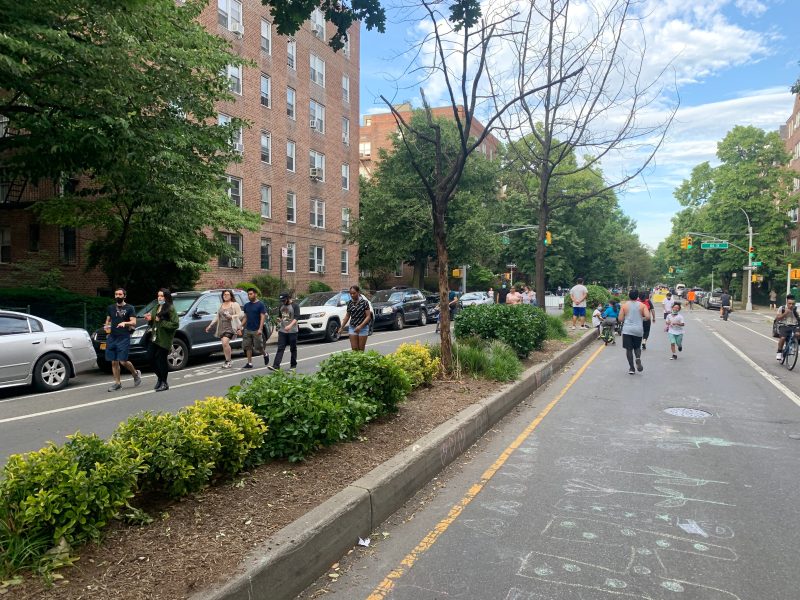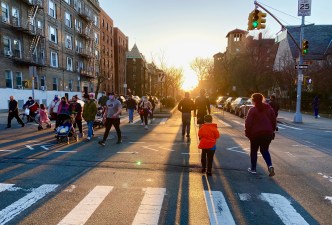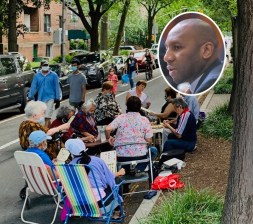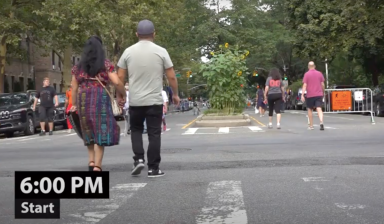Queens Pols: Make 34th Avenue Permanently Car-Free

The opening of 34th Avenue in Jackson Heights for socially responsible recreation during the COVID-19 crisis has been such an unqualified success that two key Queens pols are demanding that the de Blasio administration make the car-free zone permanent.
Council Member Daniel Dromm and State Senator Jessica Ramos say the 1.3-mile oasis between 69th Street and Junction Boulevard has created an invaluable resource for a neighborhood with limited greenspace — and the proof is revealed every day as Jackson Heights residents flock to the avenue for exercise, socially distant socializing and to let their kids frolic without the fear that they will be run over by a driver.
“We definitely can keep this closed [to cars] moving forward and keep it an open street, so that pedestrians, bike riders, children and their families, and others in the community can enjoy this,” Dromm told Streetfilms’ documentarian Clarence Eckerson Jr. in the video above.

Ramos echoed her support. “I can’t wait to push and make sure this is indeed as permanent as it can be, so that we can have more streets be for people and not for cars,” she said.

“We are living in a moment when we can radically transform how we think about our streets and our city and our life in the city and the way that we get around,” she added. “It really does take bold ideas like this to push and make sure we are changing not only policy, but the urban design that should be reflective of what our needs are today, not the needs that were decades ago.”
The needs in Jackson Heights are deep for two reasons: one is that the area is one of the hardest hit by the pandemic, with an infection rate double that of neighboring Astoria, and more than quadruple that of tony areas of Manhattan, as this New York Times city map shows. And, second, the neighborhood has very little green space, with just the small Travers Park at its center. (Dromm’s district has just 2 percent of its public space set aside as park, well below the city average, according to surveys created by New Yorkers for Parks. The neighborhood is 50th out of 51 council districts for open space)
That explains why neighbors have embraced the open streets — at least since the NYPD has been banished from the program.
In March, the city shuttered a pilot program which was staffed by dozens of police officers. But at the end of April, advocates held a rally and volunteered to open and close the streets themselves. The result has been a much-more valued community resource — and one of the most popular stretches in the mayor’s entire 40-mile open streets program.
The roadway itself works well because drivers are easily accommodated by the parallel roadways of Northern Boulevard to the north and 35th Avenue to the south. Very few drivers access 34th Avenue, thanks to the sheer numbers of people using it. A nearby open street on 39th Avenue is far less successful because too many drivers use it as a shortcut through Sunnyside.
It is unclear what a permanent open street would look like, given that it would likely not be as widely used during the winter months. The mayor has said that some of the 10 miles of temporary protected bike lanes may become permanent after the crisis is over.
The good news is the DOT is willing to discuss making it permanent.
“We are thrilled with the positive reception this project is getting, and we look forward to continuing our dialogue with community stakeholders about its future,” agency spokesman Brian Zumhagen.




